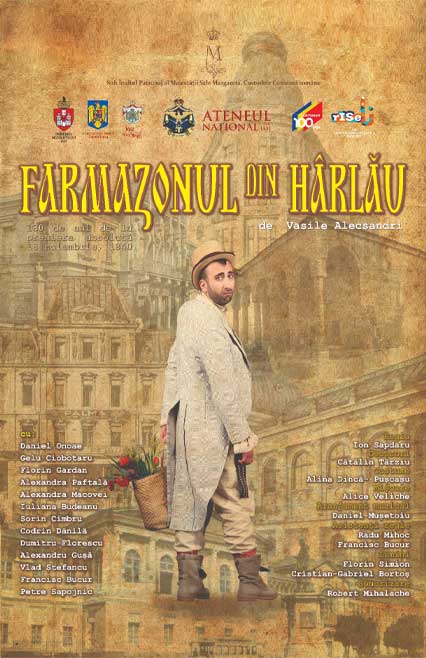The pharmazon from Hârlau
Theatre show
Young Vasile Alecsandri returns to France at the end of the 30s of the 19th century, winged by modern ideas, but also with deep impressions gathered from the theatres he tenaciously frequented in Paris. He finds a sorry state of theatre in the country. The few bands offer the public in Iași performances at an extremely precarious artistic level. A few foreign bands perform in unsuitable halls and the repertoire is disconnected from the Romanian reality. French vaudevilles, street plays and Italian operettas, that’s all the Iași audience could see. The biggest problem, however, was the Romanian language. Most of the audience was sceptical of even the idea of a performance in Romanian. It was argued that the Romanian language is not suitable for a theatrical act.
Alecsandri aims to destroy these retrograde ideas, and for this, together with M. Kogălniceanu and C. Negruzzi, they founded the National Theatre. With unparalleled enthusiasm, Alecsandri writes “The Pharmacist from Hârlău” which, with all its imperfections, is an original, well-crafted play and can be considered the play with which the National Theater was born in Romania. Alecsandri, being in a hurry to give a play for the newly established theatre, quickly writes “The Pharmacist from Hârlău”, and on November 18, 1840, the play was written in a simple style and according to both the level of education of the public and the novice talents of to the author’s new theatre lovers, it is performed on the stage of the National Theatre, being given a long standing ovation by the audience at the final curtain. The spectators felt that they were on the threshold of an important event. The event is huge! That evening, the Romanian language rang out on stage and there were probably few who didn’t like it. Through this performance, a decisive step was taken for the future of Romanian theatrical art. The Romanian language is winning a tough battle on its territory.
Briefly about the “Pharmazon from Harlau”: a young man aspiring for the hand of the servant Ganganu’s daughter, named Pestriţ, who comes from Hârlau, lands on the hand of a few Iași nobles eager for fun and parties for free. Pestriţ comes to Iași with two goals: to get married and enter the society of… pharmacists. This desire of a peasant from the country is strange and is the delight of this little play. To prevent Pestriţ’s engagement, these little swindlers from Iasi pretend to be a Freemason society and oblige themselves to welcome Pestriţ into their ranks.
The comedy acquires grotesque valences through the way the greeters imagine the reception ceremony in the Masonic lodge. The ceremony takes place, where else, then in the cellar. The naive Pestriţ is subjected to the so-called tests of the lodge, he is slapped, he invokes lightning, and he meets in the realm of death with other pretenders to the Masonic lodge, who have been wandering for weeks and cannot find their salvation. In the end, Pestriţ loses his rights as a fiance and finds out that he has actually been pranked and is not even a pharmacist. Sorrowful, Pestriţ returns to Hârlău.
The story is written with a lot of nerve and humour.
With “Farmazonun din Hârlău”, a comedy in three acts, the history of this theatre begins. The premiere took place on a Monday, November 18, 1840, and on this occasion, the book was also launched, with a vintage binding, spine and leather binding. The book has 50 pages, it is written in Romanian, but with Cyrillic characters.
So, in 2020 it will be 180 years since the song was written and staged. It was directed by Costache Caragiale, Ion Luca Caragiale’s uncle. This date is recorded as the beginning of the National Theater and the first Romanian play performed at the National Theater in Romania.
Director: Ion Sapdaru
Set: Cătălin Târziu
Costumes: Alina-Dincă Pușcașu
Movement: Alice Veliche
Music arrangement: Daniel Mușetoiu
Assistant directors: Radu Mihoc, Francisc Bucur
Lighting: Florin Simion, Cristian-Gabriel Bortoș
Sound: Robert Mihalache


Reviews for: The pharmazon from Hârlau